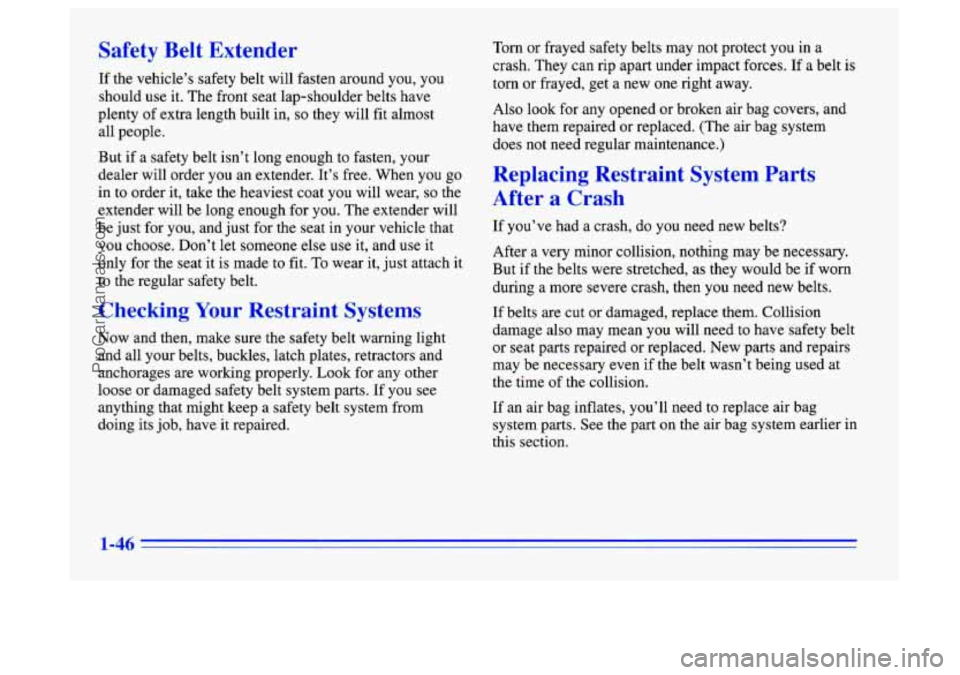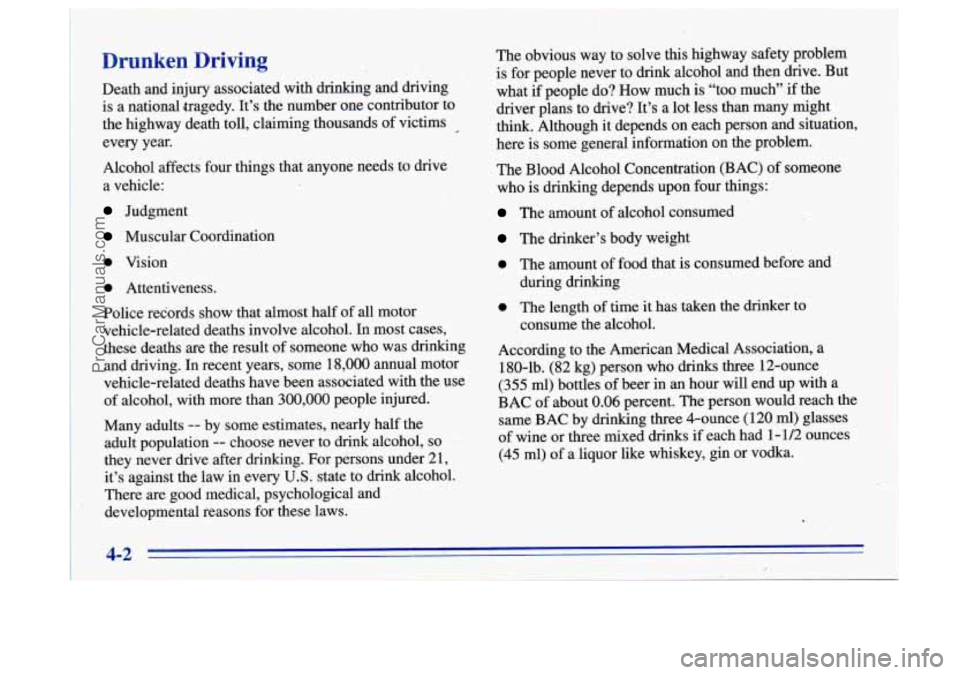Page 58 of 340

Safety Belt Extender
If the vehicle’s safety belt will fasten around you, you
should
use it. The front seat lap-shoulder belts have
plenty of extra length built in,
so they will fit almost
all people.
But if a safety belt isn’t long enough to fasten, your
dealer will order you an extender. It’s free. When you go
in to order it, take the heaviest coat you will wear,
so the
extender will be long enough for you. The extender will
be just for you, and just for the seat in your vehicle that
you choose. Don’t let someone else use it, and use it
only for the seat it is made to fit. To wear it, just attach it
to the regular safety belt.
Checking Your Restraint Systems
Now and then, make sure the safety belt warning light
and all your belts, buckles, latch plates, retractors and
anchorages are working properly. Look for any other
loose or damaged safety belt system parts. If
you see
anything that might keep a safety belt system from
doing its job, have it repaired.
Torn or frayed safety belts may not protect you in a
crash. They can rip apart under impact forces. If a belt is
torn or frayed, get a new one right away.
Also look for any opened or broken air bag covers, and
have them repaired or replaced. (The air bag system
does not need regular maintenance.)
Replacing Restraint System Parts
After
a Crash
If you’ve had a crash, do you need new belts?
After a very minor collision, nothing may be necessary.
But if the belts were stretched, as they would be if worn
during a more severe crash, then you need new belts.
If belts are cut or damaged, replace them. Collision
damage also may mean you will need to have safety belt
or seat parts repaired or replaced. New parts and repairs
may be necessary even
if the belt wasn’t being used at
the time of the collision.
If an air bag inflates, you’ll need to replace air bag
system parts. See the part on the air bag system earlier
in
this section.
ProCarManuals.com
Page 132 of 340

~ Drunken Driving The
obvious way to solve this highway safety problem
is for people never to drink alcohol and then drive. But
Death and injury associated with drinking and driving what if people do? How much is “too much” if the
I is a national Itragedy. It’s the number one contributor to
driver plans to drive? It’s a lot less than many might
i the highway death toll, claiming thousands of victims , think. Although it depends on each person and situation,
every year. here is some general information on the problem.
Alcohol affects four things that anyone needs to drive
a vehicle:
Judgment
Muscular Coordination
0 Vision
0 Attentiveness.
Police records show that almost half
of all motor
vehicle-related deaths involve alcohol. In most cases, these deaths are the result of someone who was drinking
and driving. In recent years, some 18,000 annual motor
vehicle-related deaths have been associated with the use
of alcohol, with more than
300,000 people injured.
Many adults
-- by some estimates, nearly half the
adult population
-- choose never to drink alcohol, so
they never drive after drinking. For persons under 2 1 ,
it’s against the law in every U.S. state to drink alcohol.
There are good medical, psychological and
developmental reasons for these laws. The
Blood Alcohol Concentration (BAC)
of someone
who is drinking depends upon four things:
The amount of alcohol consumed
The drinker’s body weight
0 The amount of food that is consumed before and
during drinking
0 The length of time it has taken the drinker to
According to the American Medical Association, a
180-lb.
(82 kg) person who drinks three 12-ounce
(355 ml) bottles of beer in an hour will end up with a
BAC
of about 0.06 percent. The person would reach the
same BAC by drinking three 4-ounce (120
ml) glasses
of wine or three mixed drinks if each had
1- 1/2 ounces
(45 ml) of a liquor like whiskey, gin or vodka.
consume the alcohol.
1 4-2
I
ProCarManuals.com
Page 243 of 340
4. Press the bulb housing release lever and turn the
housing
1/6 turn counterclockwise to remove it.
5. To remove the bulb, push in and rotate it
counterclockwise.
6. Reverse all steps to reassemble the taillamp.
Windshield Wiper Blade Replacement
Replacement blades come in different types and are
removed
in different ways. Here’s how to remove the
type with a spring release:
1. Pull the windshield wiper arm away from the windshield.
2. Press down on the spring with SI screwdriver and pull
the blade assembly off the wiper arm.
3. Push the new wiper blade securely onto the wiper arm.
For the replacement blade type and length, see
“Capacities and Specifications” in the Index.
6-37
ProCarManuals.com
Page 268 of 340

Refrigerant (R=l34a), Air Conditioning*
2.2L (Code 4) .................................................... 1.75 lbs. (0.8kg)
3.1L V6 (Code
M) ................................................. 2.0 Ibs. (0.9kg)
*See “Air Conditioning Refrigerants” later in this section.
Power Steering
Pump Only 2.2L
L4 (Code 4) .................................................. 1 pint (0.47 L)
3.1L V6 (Code M) ................................................. 1 pint (0.47 L)
2.2L L4 (Code 4) ................................................ 1.7 pints (0.82 L)
Wheel Nut Torque ............................................ 100 lb-ft (140 N-m)
Type
...................................................... RH/LH 4.75 pin RRpin
Length
............................................... 18” (457 mm) 16” (406 mm)
Complete System
3.1L V6
(Code M) ................................................ 1.6 pints (0.75 L)
Windshield Wiper Blade Replacement
Fuel Tank
................
Tire Pressures, Sizes ........
NOTE: All capacities are approx
manual. .i
................................... 16.5
gallons 62.4 L
........ See Tire-Loading Information label on driver’s door.
mate. When adding, be sure to fill to the appropriate level, as recommended in this
6-62
ProCarManuals.com
Page 269 of 340
Engine Specifications
2.2L
VIN Engine Code .............................. 4
Type
....................................... L4
Displacement .............................. 2.2 Liters
Firing Order
............................... 1-3-4-2
Thermostat Temperature
................... 195°F (91 "C)
Vehicle Dimensions
Sedan
Wheelbase ....................... 104.9 in. (2664 mm)
Front Tread
........................ 58.7 in (1492 mm)
Rear Tread
........................ 56.7 in. ( 1442 mm)
Overall Length
.................... 189.1 in. (4803 mm)
Overall Width
...................... 69.4 in. (1762 mm)
Overall Height
..................... 54.2 in. ( 1377 mm)
3.1L V6
M
V6
3.1 Liters
1-2-3-4-5-6
195°F (91OC)
Wagon
104.9 in (2664 mm)
58.7 in. (1492 mm)
56.7 in. (1442 mm)
190.9
in. (4851 mm)
69.4 in. (1762 rnm)
54.2 in. (1377 mm)
6-63
ProCarManuals.com